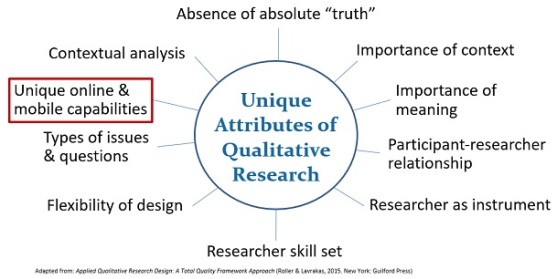
The following is a modified excerpt from Applied Qualitative Research Design: A Total Quality Framework Approach (Roller & Lavrakas, 2015, pp. 7-8).
Online and mobile technology offer unique enhancements to qualitative research designs. In many instances, these technologies have shifted the balance of power from the researcher to the online or mobile participant, who is given greater control of the research process by way of increased flexibility, convenience, and varied ways to respond in greater detail and depth to the researcher’s inquiries. For example, a participant in an email in-depth interview study can thoughtfully reflect on a researcher’s question before answering and can delay response until the participant is at a location where they can take the time to write a thoughtful reply. The opportunity to select the time and place for participation empowers online and mobile participants beyond that afforded participants of conventional, more restrictive modes that dictate a specific interview schedule or date and place for a group discussion or observation.
Asynchronous online and mobile technologies have also ushered in a richer, deeper qualitative research experience. Not only do participants have the chance to write more thoughtful responses to interview questions compared to more time-limiting modes (e.g., telephone and face-to-face), but online and mobile participants can also enrich their text responses by attaching files, images (photographs, graphics), links to websites, as well as add a voice response via VoIP (Voice over Internet Protocol) or the mobile phone device. This possibility for multimedia communication can be particularly effective, for example, when capturing in-the-moment experiences or observations via the participant’s smartphone, which may include a text message describing the event, photographs of the event, a short video of the event, and a voice message to the researcher elaborating on specific aspects of the event.
Online and mobile capabilities represent just one of the 10 unique attributes of qualitative research.
 our research outcomes hinges on the integrity of the data. The greater care the researcher takes to ensure the basic ingredients of “good” research design, the more confident the researcher and importantly the user of the research will be in the recommendations drawn from the research and its ultimate usefulness.
our research outcomes hinges on the integrity of the data. The greater care the researcher takes to ensure the basic ingredients of “good” research design, the more confident the researcher and importantly the user of the research will be in the recommendations drawn from the research and its ultimate usefulness. are: the high incidence of smartphone ownership in the U.S. (
are: the high incidence of smartphone ownership in the U.S. (